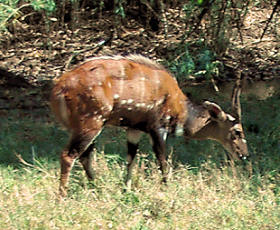 Glaciation opening new niches? The bushbuck, Tragelaphus sciptus, is sure to fill them.
Glaciation opening new niches? The bushbuck, Tragelaphus sciptus, is sure to fill them.
I finally had the chance to this paper on molecular biogeography, an interesting method of analyzing the biodiversity of widespread populations of organisms, their core habitats and their interconnectivity. The bushbuck is a perfect model; it populate most of Sub-Saharan Africa. Genetic data - from mitocondrial DNA and cytochrome b complimentary data - was contextualized and integrated with geomorphologic and climatic history. For those keeping track of the ecology basics posts, this is a perfect example of the type of research done at the landscape/geographic level.
The researchers siphoned the molecular data down to generate two basal haplogroups - two ancestral genomes, the foremothers of all bushback diversity - and using geologic and climatic history, were able to determine the probable beginnings of the bushback's spread throughout Africa. The bushback population was separated after a spell of "tectonic uplift" in the Pliocene (3+ mya), where the two new populations evolved - allopatrically - into the basal forms. The bushbuck continued to diversify as the climate changed the forested regions of its habitat into grasslands about 2.8 mya.
Using the molecular data, the researchers were able to pare down the 58 sampled ecoregions into 17 core habitats for the bushbuck, all across Africa. The ancestral organisms were probably generalist species, but again, the climatic events and glacial cycling pushed certain populations into a specialist lifestyle, able to fill the new niches without much interaction between core habitats.
Figure 1. Pan-African relationships among 23 bushbuck haplogroups in relation to toplogy and habitat heterogeneity.Part A. An unrooted median joining network of 485 control region sequences, overlaid onto a topographical map of Africa. 320 haplotypes are arranged according to original sampling location, thus describing the approximate geographic range of each terminal haplogroup. The size of each circle is scaled to haplotype frequency. A dashed white line separates Scriptus and Sylvaticus haplotypes. Relationships between intermediate-level haplogroups (thick red links) were unresolved by CR data and were inferred from a cytochrome b network (data not shown). Thick black links join terminal haplogroups nested within intermediate haplogroups and thin black links join individual haplotypes within terminal haplogroups. Inset panels B and C show the comparitive distribution of biogeographic provinces [3] and ecoregions [7] respectively.
The research is novel in its method. Connecting molecular data on a ubiquitous organism with Subspecies categorization and analysis is often arbitrary and inaccurate. By splitting up the bushbuck into distinct haplogroups, the problem of determining its evolutionary heritage as a species as well as its diversification into particular niches around the continent becomes clearer and far more accurate.
Photo by: Hans Hillewaert
- Log in to post comments

Only under particular simplifying assumptions about the population genetics. Mitochondrial genomes can have their own history apart from the rest of the genome, prone to selective sweeps and introgression. While it is certainly possible that the above scenario is clearer and more accurate, it is also possible that it is clearer but wrong. Without additional data, you're putting a lot of faith in a single marker.